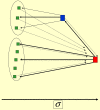Emergence of Leadership in Communication
- PMID: 27532484
- PMCID: PMC4988655
- DOI: 10.1371/journal.pone.0159301
Emergence of Leadership in Communication
Abstract
We study a neuro-inspired model that mimics a discussion (or information dissemination) process in a network of agents. During their interaction, agents redistribute activity and network weights, resulting in emergence of leader(s). The model is able to reproduce the basic scenarios of leadership known in nature and society: laissez-faire (irregular activity, weak leadership, sizable inter-follower interaction, autonomous sub-leaders); participative or democratic (strong leadership, but with feedback from followers); and autocratic (no feedback, one-way influence). Several pertinent aspects of these scenarios are found as well-e.g., hidden leadership (a hidden clique of agents driving the official autocratic leader), and successive leadership (two leaders influence followers by turns). We study how these scenarios emerge from inter-agent dynamics and how they depend on behavior rules of agents-in particular, on their inertia against state changes.
Conflict of interest statement
Figures











Similar articles
-
Leader emergence through interpersonal neural synchronization.Proc Natl Acad Sci U S A. 2015 Apr 7;112(14):4274-9. doi: 10.1073/pnas.1422930112. Epub 2015 Mar 23. Proc Natl Acad Sci U S A. 2015. PMID: 25831535 Free PMC article.
-
When timing is key: How autocratic and democratic leadership relate to follower trust in emergency contexts.Front Psychol. 2022 Aug 3;13:904605. doi: 10.3389/fpsyg.2022.904605. eCollection 2022. Front Psychol. 2022. PMID: 35992493 Free PMC article.
-
Too tired to inspire or be inspired: Sleep deprivation and charismatic leadership.J Appl Psychol. 2016 Aug;101(8):1191-9. doi: 10.1037/apl0000123. Epub 2016 May 9. J Appl Psychol. 2016. PMID: 27159583
-
Attachment and leadership: review and new insights.Curr Opin Psychol. 2019 Feb;25:157-161. doi: 10.1016/j.copsyc.2018.08.003. Epub 2018 Aug 6. Curr Opin Psychol. 2019. PMID: 30107317 Review.
-
[Charisma and leadership: new challenges for psychiatry].Encephale. 2013 Dec;39(6):445-51. doi: 10.1016/j.encep.2012.10.006. Epub 2012 Dec 13. Encephale. 2013. PMID: 23246329 Review. French.
References
-
- Encyclopedia of leadership. Goethals GR, Sorenson GJ, Burns JM, editors. Thousand Oaks, California: Sage; 2004.
-
- Winkler I. Contemporary Leadership Theories. Berlin: Springer-Verlag; 2010.
-
- Katz E, Lazarsfeld PF. Personal Influence: The Part Played by People in the Flow of Mass Communication. Glencoe: Free Press; 1955.
-
- Beckman MD. Are your messages getting through? Journal of Marketing. 1967: 31, 34–38. 10.2307/1249027 - DOI
-
- Troldahl VC. Public Opinion Quarterly. 1966: 23; 609–614.
MeSH terms
LinkOut - more resources
Full Text Sources
Other Literature Sources
Medical

